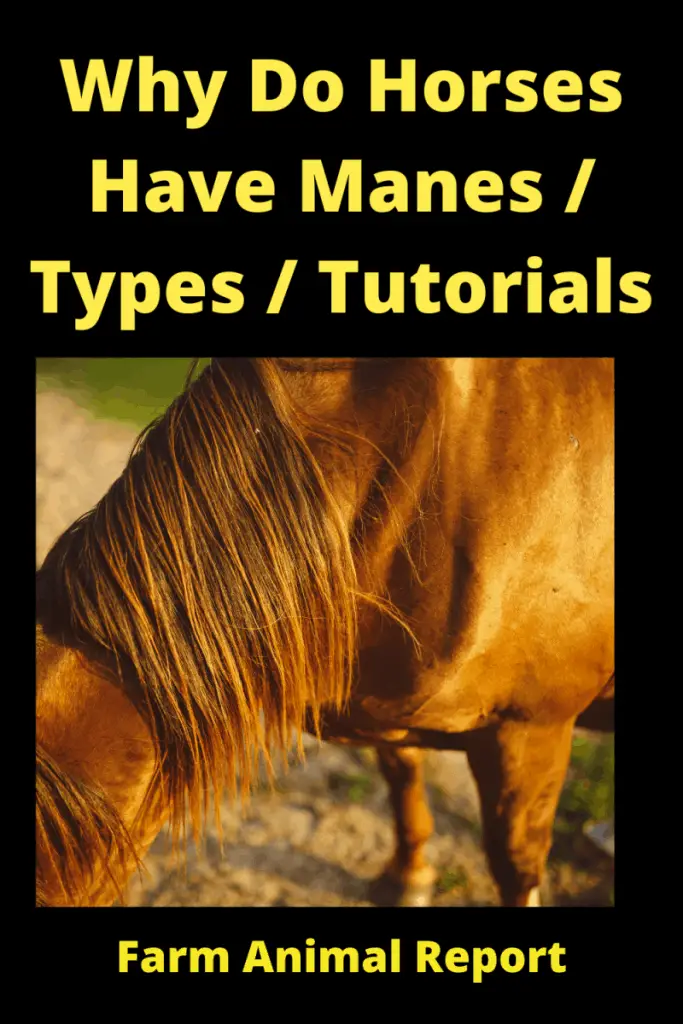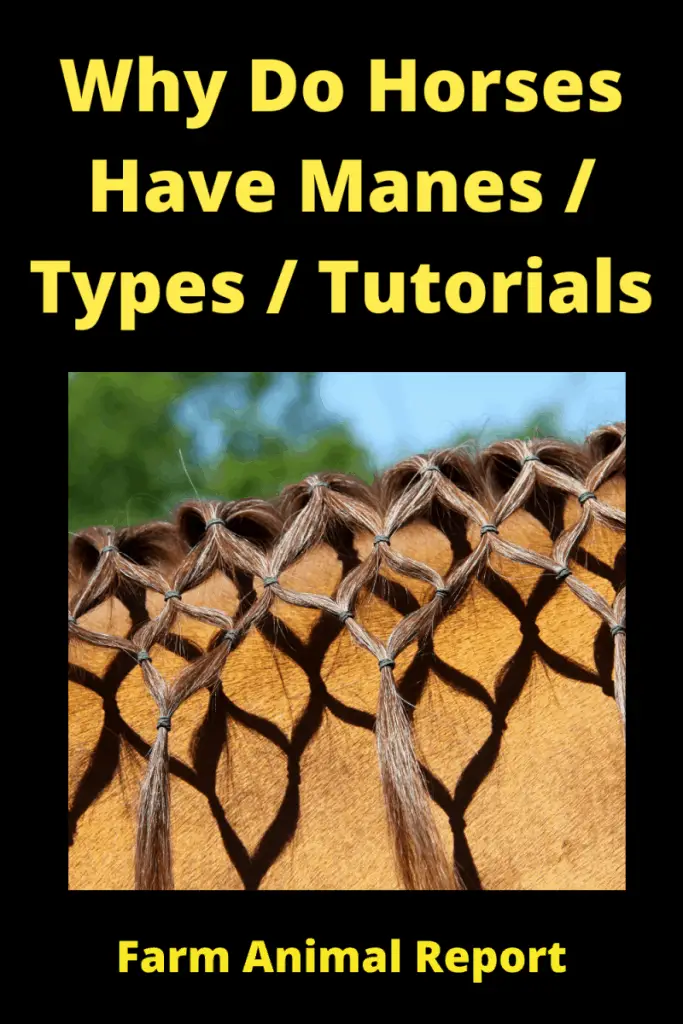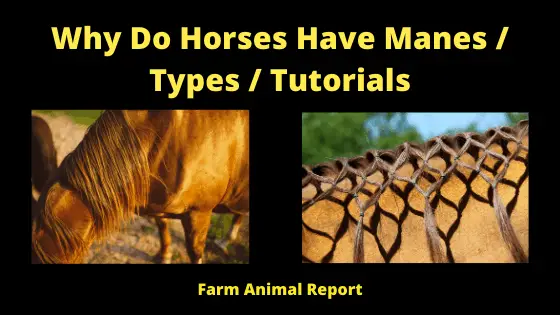Why Do Horses Have a Mane?
Why Do Horses Have Manes – The mane is thought to keep the neck warm and possibly help water run off the neck if the animal cannot obtain shelter from the rain. It also provides some fly protection to the front of the horses, although the tail is usually the first defense against flies. Length and Thickness are Genetic.
These are not the original purposes. Why Do Horses Have a Mane?
The longer mane is specifically bred gene defect to visualize the part for humans.
What is the Mane?
Mane, in horses, is the hair that grows from the top of the neck of a horse or other equine, reaching from the poll to the withers, and includes the forelock or the foretop. It is thicker and coarser than the rest of the horse’s coat and naturally grows to cover the neck roughly. Heredity plays a role, giving some horses a longer, thicker mane, others a shorter and thinner one.
Check Out Amazon’s Resources for Raising and Training Horses
Some horses, such as those used in circuses or mounted displays such as Cavalia, have manes allowed to grow down to their knees. Others have their manes deliberately shaved completely off for style or practical purposes.
See Our Guide – 10 Ways Horse Farmers Make Money
Whenever ungroomed, however, the mane usually grows no longer than the width of the horse’s neck, as natural wear and tear limits its natural length.
Ponies usually have the thickest mane, with horse breeds with tremendous variation in thickness and length. Other equids such as the donkey often have very sparse and thin manes.

Braiding of Horses
Today, braiding is performed to show off the neck, accentuating the top line when the horse is moving or jumping. Braiding may be used to hide conformation faults of the neck. For example, a relatively short neck can be braided with a greater number of smaller braids, making it look longer. Braiding can be used to train the mane to lie on one side of the neck if half falls on one side and half falls on the other.
Traditionally, the mane is braided on the right side of the neck. This is still standard for show hunters in the United States and eventers, although the dressage horses are commonly braided. It was also traditional that male horses would have an odd number of braids and even several mares. However, this rule is rarely, if ever, followed by braiders.
Types of Braid / Button + Flat
The most common braids used are button braids in horses, which are round and usually larger than hunter or “flat” braids. In the UK, show horses of all types are plaited with between 9 to 15 plaits similar to the American “button braids.” An odd number of plaits is traditional, although judges have become more relaxed about this in recent years. The number of plants can be increased or decreased, depending on whether the rider wants the horse’s neck to look longer or shorter.
1. Hunter Braids
Hunter braids or flats are similar, with as many as 20 to 30 on a neck, and they are only braid considered traditional in US hunt seat competition. They are usually not seen in other disciplines, although they are permissible to dressage.

2. Knob Braids
Knob braids are a variation on hunter braids, involving pushing part of the braid up to create a knob at the top. They are usually seen in dressage competition, though they are also popular in other flat classes, particularly at breed shows and jumpers.
3. The French Braid / Andalusian
The French braid also called an “Andalusian braid,” is braided along the neck’s crest. It is used on long mane horses and is usually seen either when baroque horse breed competes in dressage, or hunter and dressage classes for horses that are otherwise required to show along with a long, full name.
4. The Continental Braid
The continental braid, called” macrame braid,” is also useful for long-maned horses, and creates a net in the mane. It is not a braid per se, as it is usually made up of simple knots or simply created with rubber bands or yarn. It is periodically viewed as stylish in some dressage, and flat classes, particularly those in breed shows for horses that have naturally long manes.
5. The Scalloped Mane
The scalloped mane is a less common form of braiding, where each braid is pulled up under the one which is two down from it towards the withers, forming a series of loops. This is seen most often in hunt seat, dressage, or in the jumpers, although it is not as popular as the other braid forms. It is useful for manes that may look bulky in traditional braiding styles because they are too thick or too long.
Myth about Horses
“mane pulling in horses does not hurt them.”
This myth is supported by the idea that pulling mane in horses does not hurt them as horses do not have nerves in their hair follicles as we do have them.
Fact
Horses have sensory nerves in their hair follicles. Mane pulling can cause discomfort or pain in horses.
While some horses may be more tolerant than others of mane pulling, there are kinder ways to shorten and thin a horse’s mane. For example, backcombing the mane and then using a safety razor comb to trim the longer hairs works just as well as mane pulling, without causing the horse pain. Here is a clip of a mane being thinned with a razor comb. Sometimes a horse finds the clipping of hair a painful memory.
In this instance, this indicates a painful memory. The pony previously may have experienced traditional, painful mane pulling; now, he anticipates pain while undergoing the procedure. In situations like this, it is helpful to use counter conditioning to make the experience even more pleasant for the pony. Counter conditioning is a technique that can be used to change an animal’s emotional response to a trigger. In this instance, backcombing is the trigger used to predict pain, and pony still remembers. A counter-conditioning program could be used to change the pony’s emotional response, and backcombing could instead begin to have in your training toolbox. It can help horses overcome pain memories, just like the one we might be seeing here.
Roached mane
Most of us who enjoy horses are drawn to ones with a lot of hair. I understand a lot of volume on a horse’s mane, and the tail is genetic, but we all try to do our part to add to it. We labor, foster, and care for our manes to help them grow to stay as thick and beautiful as possible. We have used braids, special products, and even changed dietary supplements to attempt to keep a man healthy, strong, and well marvelous. So, if the sad morning comes when we go to catch our gelding and see that this mane has been rubbed or chewed off, it can be borderline devastating.
Patience is a key, of course. I have sometimes just let time do the trick and let the mane be ragged until it grows long enough to flip over. But if mane has gone bare in specific spots or has worn too thin, but the best approach is simply to roach the mane.
Roaching a mane entails evenly shaving the whole thing off down to the base of the neck from where it grows. It’s a fairly handy procedure and commonplace in some disciplines, including polo ponies and field hunters. The mane interferes with the reins and the high speed of mallets, so it is easier for them to shave the mane down to the neck and be done with it. Sometimes ropers and ranch cowboys will roach a mane, just for the ease of grooming and to keep any hair from getting tangled in the rope.
A horse with a roached mane does not have some fly protection. They get a Trojan war horse vibe when the mane has grown out but is not quite long enough to pick a side to fall on. And if you are reaching to grab some mane in the middle of a bronc ride or merely trotting around bareback, you will find yourself lacking in the security department. But something is appealing about having a roached mane, especially when it is done in a tidy, thoughtful, and thorough manner.
There will never be anything to me as stunning as a horse with a naturally long, thick, and well-kept mane. There is something cool about a bare necked horse with the right kind of features. It is a kind of punchy, definitely low maintenance, and it is going to grow back, looking better than ever.
How to make horse’s mane lie on the right side?
The hair on a pony or other horses is usually hanging on both sides or the wrong side. This is especially common in a pony or draft horse’s bloodlines that have thick manes. Many horses have a mane that is lying on the wrong side. Here is how to tame a curly, two-sided mane, so it lays neatly on the right side.
Choosing the correct side
Generally, the mane lying on the right side or offside is considered correct. If you pleasure rides or shows in low-level shows, which side your horse’s mane lies on may not matter. At higher level shows, where good turnout is essential, your horse’s mane should lie smoothly on the right side of its neck. It may also be thinned or braided.
Teach your horse’s mane to lie correctly before you thin it, and you will have a little easier time getting it to eat and even. Folklore suggests that a horse’s handedness is indicated by which way the mane lies at the withers. If your horse’s mane lies to the left at the withers, you may find that it works better to the left with ridden. Alternatively, horses with their mane lying to the right may work better to the right when ridden. Changing the sides, it lies on will not likely change your horse’s performance.
How to change the side of your horse’s mane lies on.
Comb out the mane, so it is neat, tangle-free, and all are lying on one side of the horse’s neck. A grooming spray can help work out any tangles and prevent breakage, making a mane look frizzy. Once the mane is smooth, dampen it slightly. Divide the mane into two sections about 1 to 2 inches wide up the neck.
Braid each section and secure it with a thread or elastic. You might want to pick up a package of small braiding elastics at your local tack shop. Don’t braid the tuft of mane at the withers. It does not matter if the braid looks nice. They do not need to be particularly even in width or length; you just need them to hold all of the manes on the side you choose. The weight of the braids over the short time will encourage the mane to lay on one side.
After a week, pull out the braid, comb out the mane, others can take a few weeks. If the braids start to fall out, start again, smoothing and braiding the mane. If your horse has particularly thick, untamable mane, the process can take much longer. It can come undone, so you might have to repeat the process so often.
This is the only time you will want to leave your braids in your horse’s mane. Do not leave the braids in and not take them occasionally for grooming or leave your horse out with show braids after the show is over.
If the braids are left in for a long time, the hair will break and tangle,
leaving your horse with a curly uneven mane. This will not look nice and will make extra work for you, untangling the snarls.


